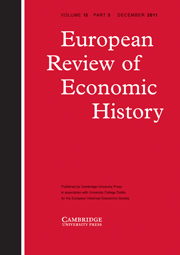Crossref Citations
This article has been cited by the following publications. This list is generated based on data provided by
Crossref.
Hale, Matthew
Hawkins, Richard
and
Wright, Catherine
2009.
List of publications on the economic and social history of Great Britain and Ireland published in 2008.
The Economic History Review,
Vol. 62,
Issue. 4,
p.
953.
PRATT, DAVID
SCHOFIELD, P. R.
HEALEY, JONATHAN
KIRBY, PETER
BRADLEY, KATE
TAYLOR, JAMES
and
BROWNLOW, GRAHAM
2010.
Review of periodical literature published in 2008.
The Economic History Review,
Vol. 63,
Issue. 1,
p.
187.
HICKSON, CHARLES R.
TURNER, JOHN D.
and
YE, QING
2011.
The rate of return on equity across industrial sectors on the British stock market, 1825-701.
The Economic History Review,
Vol. 64,
Issue. 4,
p.
1218.
Grossman, Richard S.
Lyons, Ronan C.
O'Rourke, Kevin
and
Ursu, Madalina
2013.
A Monthly Stock Exchange Index for Ireland, 1864-1930.
SSRN Electronic Journal,
Grossman, Richard S.
Lyons, Ronan C.
O'rourke, Kevin Hjortshøj
and
Ursu, Madalina A.
2014.
A monthly stock exchange index for Ireland, 1864–1930.
European Review of Economic History,
Vol. 18,
Issue. 3,
p.
248.
Foley-Fisher, Nathan
and
McLaughlin, Eoin
2016.
Capitalising on the Irish land question: land reform and state banking in Ireland, 1891–1938.
Financial History Review,
Vol. 23,
Issue. 1,
p.
71.
Stuart, Rebecca
2017.
Co-movements in stock market returns, Ireland and London 1869–1929.
Financial History Review,
Vol. 24,
Issue. 2,
p.
167.
Kenny, Seán
and
Lennard, Jason
2018.
Monetary aggregates for Ireland, 1840–1921.
The Economic History Review,
Vol. 71,
Issue. 4,
p.
1249.
Kelly, James
and
Bartlett, Thomas
2018.
The Cambridge History of Ireland.
Andersson, Fredrik N G
and
Lennard, Jason
2019.
Irish GDP between the Famine and the First World War: estimates based on a dynamic factor model.
European Review of Economic History,
Vol. 23,
Issue. 1,
p.
50.
Kenny, Seán
Lennard, Jason
and
O'Rourke, Kevin Hjortshøj
2023.
An annual index of Irish industrial production, 1800–1913.
The Economic History Review,
Vol. 76,
Issue. 1,
p.
283.
Kenny, Seán
2024.
Irish GDP since independence.
The Economic History Review,


